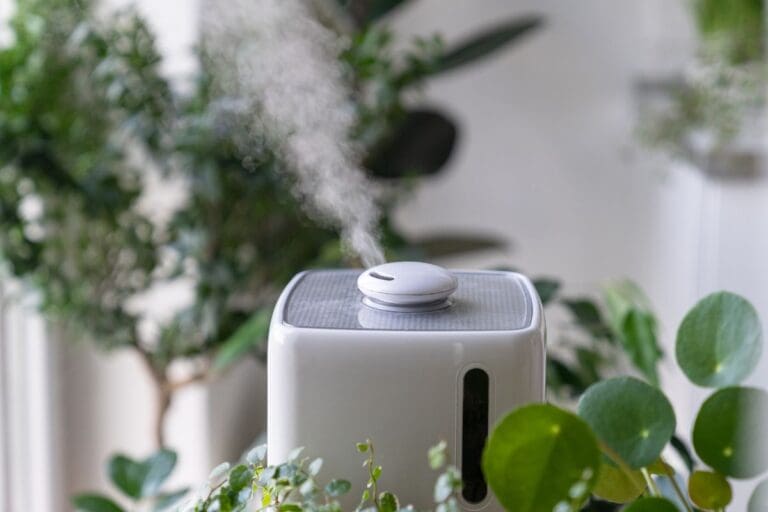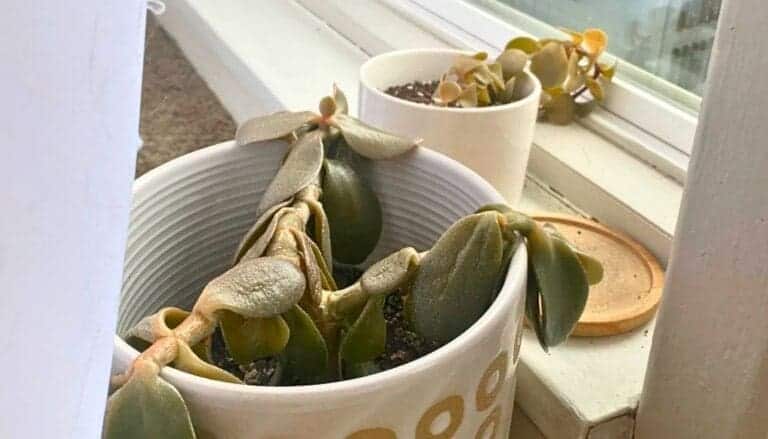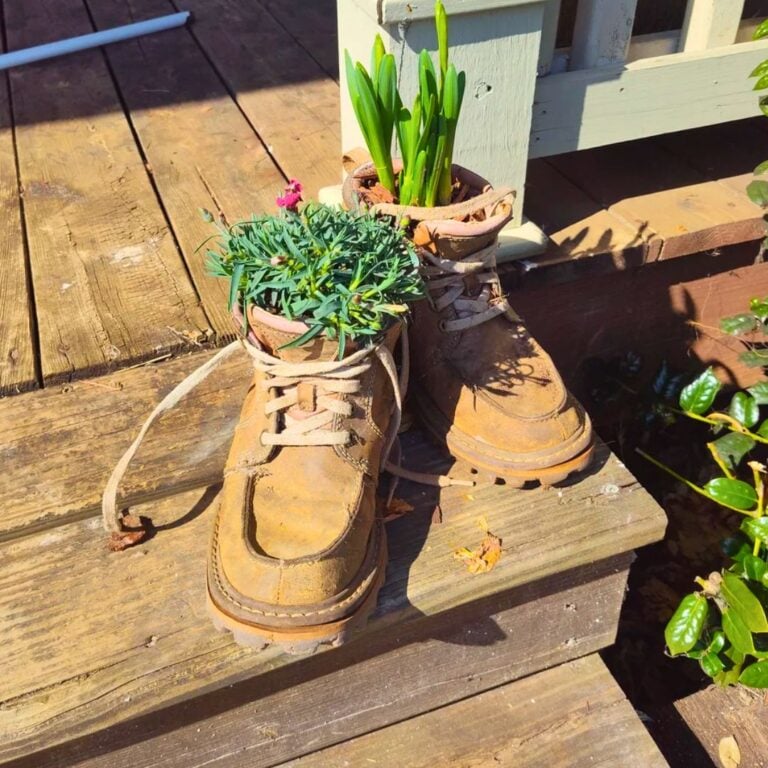10 Ways to Help Tropical Plants Survive the Cold Indoors
I absolutely love filling my home with tropical plants, but let’s be honest—it gets a little tricky when the weather turns cold.
The changes in light, temperature, and humidity can really throw them off indoors.
Learning how to adjust their environment makes the winter months so much easier for both me and my plants.
I’ve learned that even small tweaks in placement, lighting, or warmth can have a huge impact.
With the right setup, you can shield your plants from drafts, dry air, and those sneaky chilly nights—helping them stay strong and vibrant inside.
Please note: Simplify Plants is reader-supported. As an Amazon Associate, I earn from qualifying purchases made by our readers with no extra cost added to you all! Some links in the post are affiliate links and I get a commission from purchases made through links in the post.
1) Place plants near south-facing windows

When it gets cold, I always move my tropical plants to south-facing windows. These spots get the most sunlight, and honestly, my plants just look better and perkier there.
The extra light gives them the energy to keep growing, even when the days are short. I swear the leaves stay greener and the plants just seem happier when they’re soaking up steady sun.
I keep them close to the window, but not squished up against the glass. Cold drafts from windows can do a number on leaves, so I leave a little space for peace of mind.
If I notice the light is weak or there are shadows, I’ll shift the pots around until I find the brightest spot. It’s a small thing, but it pays off for my tropical plants every winter.
2) Use a humidity tray with pebbles and water

Dry indoor air in winter is the worst for tropical plants, so I like giving them a little extra humidity. A tray with pebbles and water is my go-to.
I set a shallow tray under the plant, fill it with small pebbles, and add water just below the tops of the stones. The pot sits on the pebbles, not in the water.
As the water evaporates, it creates a subtle moisture boost around the plant. The leaves seem to stay fresher and don’t dry out as fast.
I check the tray pretty often to make sure it’s not empty. If the water’s gone, the magic stops working. Topping it up takes seconds and keeps my plants comfy.
I’ve found this works best if I also keep the plants away from heating vents. The tray adds gentle humidity without making everything feel muggy. It’s a tiny effort for steady results.
3) Install a space heater with thermostat control
A space heater with a thermostat is a lifesaver for keeping my plant room cozy. Sudden temperature drops just stress out tropical plants, so I set the thermostat to the perfect warmth.
I keep the heater a safe distance from my plants. Direct heat can dry out leaves—nobody wants crispy edges—so I make sure the warmth spreads through the whole room.
The thermostat does the work for me, turning the heater on and off as needed. No more rooms that are too hot or too cold, and it saves energy too.
When I use a space heater, I keep an eye on the humidity. Warm air can dry things out, so I’ll add a humidifier or a water tray nearby if things feel parched.
4) Apply a layer of mulch on soil surface
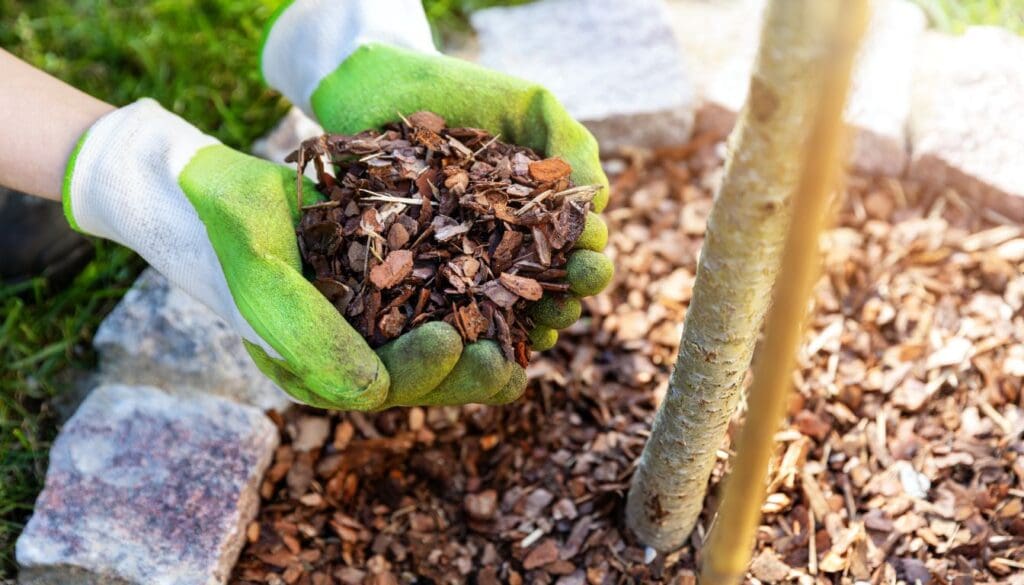
I like tossing a light layer of mulch on the soil when my tropicals come inside. It keeps the soil moist longer, so I’m not watering every other day.
Mulch also acts as a temperature buffer. It slows down how fast the soil gets cold, which is a big deal for sensitive roots.
I usually go for natural stuff like shredded bark, coconut husk, or even some dry leaves. They’re safe indoors and break down slowly.
The layer doesn’t need to be thick—about an inch is plenty to protect the soil without suffocating it.
With the soil covered, I notice fewer wild swings in moisture and temperature. It’s a small step, but it really helps in winter.
5) Group plants together to create microclimate

I like to cluster my tropical plants when it’s cold. They share moisture and warmth, which helps fight off that dry winter air.
Grouping them means humidity stays higher around the leaves. It’s a simple trick, but tropicals need more moisture than my house usually has in winter.
I’ve also noticed that clusters cut down on drafts. A bunch of plants together creates a more stable environment, so they’re less shocked by temperature shifts.
Sometimes I’ll put a tray of water nearby. As it evaporates, the humidity bumps up even more, and the plants seem to love it.
I keep enough space between pots for air to move around. That way, I don’t end up with mold or pests, but the plants still get the perks of their little microclimate.
6) Use grow lights for 12-16 hours daily
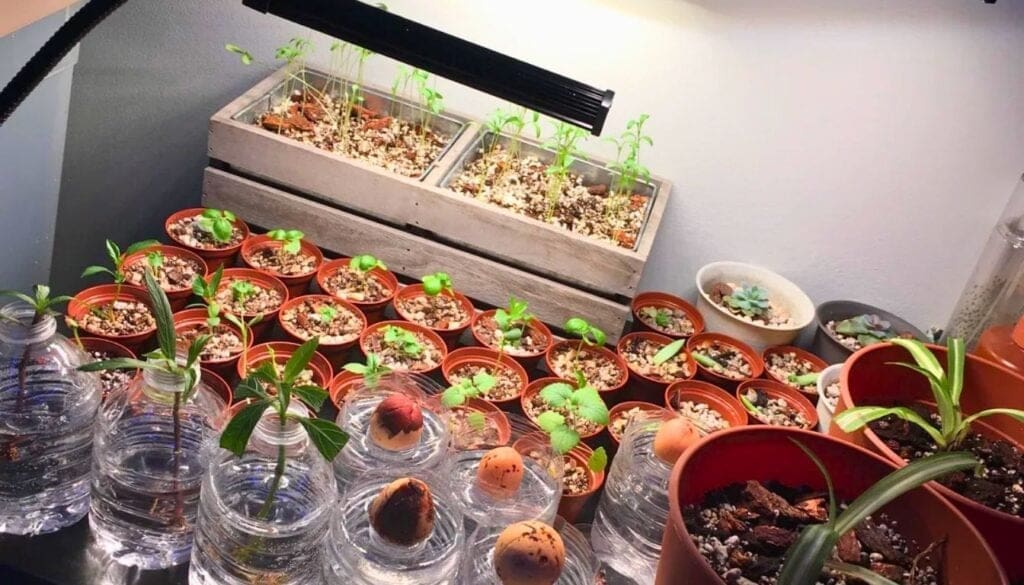
I rely on grow lights during the cold months because sunlight just isn’t enough indoors. The extra light keeps my tropicals from getting sluggish.
I run the lights for 12-16 hours a day to mimic their natural environment. This regular cycle really helps them keep growing instead of going dormant.
The lights sit about 6-12 inches above the plants—close enough for brightness, but not so close they get scorched. I watch for any signs of stress, just in case.
I’m a fan of LED grow lights. They’re energy efficient and don’t make the room hot, so I can leave them on for hours without worry.
Timers are a lifesaver here. I set them and forget them, which means the plants get consistent light every day.
With the right lighting, my plants stay strong and green—even when it’s freezing outside.
7) Mist leaves regularly with water
Misting is one of my favorite habits for tropical plants. The dry air indoors, especially with the heat on, can really stress them out. A quick mist helps.
I use a spray bottle with clean water and give the leaves a light spritz a few times a week. I’m careful not to overdo it—too much water can cause spots or mold.
I usually mist in the morning so the leaves dry by evening. That cuts down on any mildew issues and keeps the plants looking fresh.
Plants with broad leaves—like philodendrons or calatheas—really seem to appreciate it. They look less dusty and stay greener.
Honestly, misting takes a minute, but it makes a surprisingly big difference for my tropicals during winter.
8) Avoid sudden temperature drops at night

I’m always on guard against sharp temperature changes at night. Tropical plants like steady warmth, and a quick chill can really mess them up.
I keep them away from drafty windows and doors. Cold air sneaking in after dark can drop the temperature around the plant fast.
Heaters and vents are tricky too. The heat feels fine during the day, but when it shuts off at night, the sudden change isn’t great for the plants.
If the room cools off at night, I’ll use curtains or blinds to block cold air. It helps keep things more stable.
Sometimes, I set up a small space heater with a thermostat to keep the room from getting too chilly. Not too hot, just steady.
Keeping the temperature steady really helps my plants hold onto their leaves. Consistency is key for happy tropicals.
9) Keep plants away from cold drafts
Cold drafts are a no-go for my tropical plants. Even a tiny chill from a window crack or door can stress them out. These sudden temperature changes just slow everything down.
I check windows, doors, and vents for any hint of a breeze. If I feel it, I know my plants will too. Moving them a few feet away can make a big difference.
I skip placing plants near heaters or air vents. The air there is either too dry or too cold, depending on the season. I look for spots with a stable temperature.
When I open windows for fresh air, I make sure the plants aren’t in the draft. Consistent warmth helps them stay healthy, so I’m pretty picky about their placement.
A little extra attention here keeps my plants safe and comfortable indoors.
10) Use thermal curtains to insulate windows
Thermal curtains are a game-changer for keeping my plants cozy near windows. They block out chilly air that sneaks in during winter, giving my tropicals a more stable temperature.
At night, I close the curtains and the room holds warmth way better. During the day, I open them up for sunlight. It’s a nice balance and keeps the plants from getting shocked by temperature swings.
I’ve also noticed thermal curtains help with energy loss, so my heating bill isn’t as scary. That’s a bonus for me and my plants.
If the plants are close to a window, I make sure the curtain goes all the way to the floor. It helps seal out the cold and keeps things warmer for the plants.
Pairing thermal curtains with other steps, like moving plants from direct drafts, makes a noticeable difference. Even these little changes can help tropical plants thrive indoors.
Understanding Tropical Plant Needs
I try to pay close attention to how temperature changes affect my tropical plants. Watching for those early warning signs really helps me keep them happy indoors when it’s cold out.
How Cold Affects Tropical Plants
Tropical plants come from warm, humid regions, so cold air stresses them pretty quickly. When the temperature drops below 60°F (15°C), a lot of them slow their growth or just stop growing altogether.
If it gets much colder, leaves may turn yellow or drop. Cold air also makes it harder for plants to absorb water and nutrients, which is honestly a problem.
Roots can get weak, and sometimes the plant just looks dull or a bit limp. Even a brief draft from a window or door can be enough to freak them out—I’ve seen it happen.
To keep them safe, I try to keep my plants away from cold glass, vents, and doors. I’ll use a small thermometer near my plants just to be sure the room stays in a good range.
Ideal indoor temperatures? Usually somewhere between 65–75°F (18–24°C) during the day, and a little cooler at night.
Recognizing Signs of Stress
When my tropical plants get too cold, the signs are usually pretty obvious. Yellowing leaves are often the first thing I notice, sometimes followed by wilting or drooping.
If it keeps up, leaves may turn brown at the edges or just fall off. I also watch for slowed growth—if a plant that usually puts out new leaves suddenly stops, that’s a red flag.
Sometimes the soil just stays wet forever because the roots aren’t pulling in water like they should. To keep an eye on things, I check my plants every few days.
I’ll jot down a quick note about leaf color, soil moisture, and just how the plant looks overall. If I catch stress early, it’s way easier to fix the environment before things get out of hand.
Optimizing Your Indoor Environment
When I bring my tropical plants inside, I mostly focus on two things: keeping the air moist enough and making sure they get the right amount of light.
Those details really matter—small changes indoors can make a huge difference for plant health.
Maintaining Proper Humidity Levels
Tropical plants like more moisture in the air than most homes have in winter. I usually run a humidifier near my plants and try to keep the humidity around 50–60%—it really helps prevent dry leaves and those annoying brown tips.
If I don’t have a humidifier, I’ll group my plants together to create a mini pocket of higher humidity. Sometimes I set a tray of water with pebbles under the pots, too.
As the water evaporates, it adds a bit of moisture to the air. I’ll mist my plants lightly now and then, but I’m careful not to overdo it since too much water on leaves can lead to mold.
To keep track, I use a small hygrometer. That way, I know the humidity level for sure and don’t have to just guess.
Adjusting Light for Winter Months
Shorter days in winter mean less sunlight for my plants, so I move them closer to south- or east-facing windows where they can soak up more natural light. I make sure the leaves don’t actually touch the cold glass—it’s easy to forget, but it can do real damage.
When there’s not enough natural light, I’ll use grow lights set on a timer for about 12–14 hours a day. LED grow lights are my favorite since they don’t get too hot.
I also rotate my plants every week so all sides get a fair share of light. That way, they don’t end up leaning or growing lopsided.
Frequently Asked Questions
I try to stay on top of temperature, humidity, light, fertilizer, watering, and spotting early signs of stress. These little things make a huge difference when I’m trying to protect my tropical plants from the cold.
What temperatures are considered too cold for tropical plants indoors?
I keep my tropical plants in rooms that stay above 60°F. If it drops below that, they really start to struggle.
A space heater with thermostat control helps me keep things steady.
How can I increase humidity for my indoor tropical plants during winter?
I use a humidity tray with pebbles and water right under the pots. Grouping my plants together creates a small microclimate that keeps the air around them more moist.
What are the best practices for lighting tropical plants indoors in colder months?
I put my plants near south-facing windows for the most sunlight. If the days are super short, I’ll add a grow light to keep things bright enough.
Can I use fertilizers on my tropical plants in winter, and if so, which ones?
I go pretty light on fertilizer in winter since growth slows down. When I do feed, I use a diluted balanced fertilizer about once a month.
How often should I water my tropical plants when they’re indoors and it’s cold outside?
I check the soil before I water—if the top inch feels dry, I’ll add water. Sometimes I put a thin layer of mulch on the soil to help keep moisture steady.
Are there any specific signs of cold damage I should look for in my tropical plants?
I usually keep an eye out for yellowing leaves, brown edges, or drooping stems—those are the big red flags in my experience. If I spot any of these, I’ll move the plant somewhere warmer as soon as I can.
Recommended Garden Supplies
| Product Image | Our Recommended Gardening Supplies | Check Offers! |
|---|---|---|
Top Top
Top
Top
Top
Top
Top
Top
Top | rePotme Houseplant and Tropical Classic Potting Soil Mix | Check Offer On Amazon |
 Top
Top
Top
Top
Top
Top
Top
Top | Espoma Organic Indoor Plant Food | Check Offer On Amazon |
 Top
Top
Top
Top
Top
Top
Top
Top | GooingTop LED Grow Light 6000K Full Spectrum Clip Plant Growing Lamp | Check Offer On Amazon |
 Top
Top
Top
Top
Top
Top
Top
Top | Soil Moisture Meter | Check Offer On Amazon |
 Top
Top
Top
Top
Top
Top
Top
Top | Govee Hygrometer Thermometer, Bluetooth Enabled! | Check Offer On Amazon |
 Top
Top | LEVOIT Humidifiers for Large Room(Best For Plants) | Check Offer On Amazon |
 Top
Top
Top
Top
Top
Top
Top
Top | Upgraded DIY Automatic Drip Irrigation Kit, 15 Potted Houseplants Support | Check Offer On Amazon |
 Top
Top
Top
Top
Top
Top
Top
Top | Stainless Steel Heavy Duty Gardening Tool Set | Check Offer On Amazon |
 Top
Top
Top
Top
Top
Top
Top
Top | Bonide Insecticidal Soap | Check Offer On Amazon |
 Top
Top
Top
Top
Top
Top
Top
Top | Bonide 32 oz Spray Neem Oil for Organic Gardening | Check Offer On Amazon |
 Top
Top
Top
Top
Top
Top
Top
Top | Garden Safe Fungicide | Check Offer On Amazon |



